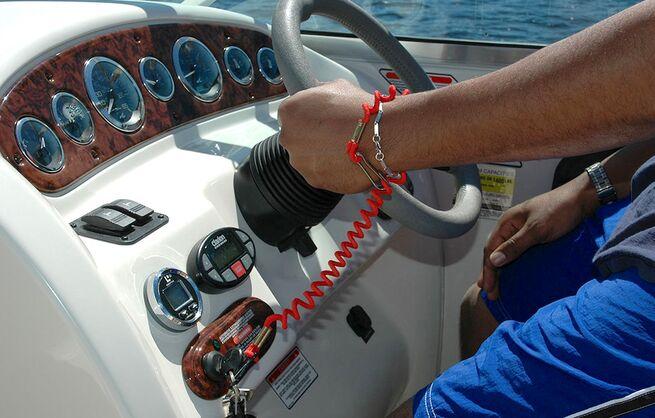
What Piece of Equipment on a Boat is Most Important in Preventing Propeller Strike Injuries?
Table of Contents
We understand that acing the boating test can be quite challenging, but it’s a crucial component of keeping yourself and others safe on the water. As you prep for your test, you’ll come across one question that a lot of people get wrong: what piece of equipment on a boat is most important in preventing propeller strike injuries?
In this article, we’re going to answer this question and explain in great detail what you must do to prevent propeller strike injuries.
What Piece of Equipment on a Boat is Most Important in Preventing Propeller Strike Injuries?
A boat’s ignition safety switch lanyard, or kill switch, is the #1 most important piece of equipment to prevent propeller strike injuries. If the captain must leave the helm, passes out, or has a medical emergency, the kill switch will cut the engine.
You will likely also see the following answers on the boating test when asked “What piece of equipment on a boat is most important in preventing propeller strike injuries?”:
- Steering control
- Ignition safety switch lanyard
- Self-circling device
- USCG-approved life jacket
However, the correct answer to this question is “ ignition safety switch lanyard.”
More important than knowing the right answer is understanding why it’s such an important question to ask. Here’s some useful background information on this question:
In 2024, at least one person in 173 accidents was struck by a propeller. These propellor-related boating incidents resulted in:
- 41 deaths
- 182 injuries
The good news is that the total accidents involving propellers are down 30% since 2020. A lot of this improvement is attributed to more robust captain’s training and advancements in safety features, such as ignition kill switches, resulting in fewer boating accidents involving propellers. As more captains know what piece of equipment on a boat is most important in preventing propeller strike injuries, the less likely injuries are to occur.
So how does this work? The ignition safety switch lanyard works by connecting to the captain’s wrist or belt loop.

It’s essentially a cord (or rope) that connects from the boat’s ignition (where the key goes in) to the captain’s body. If the captain moves away from the steering wheel (also known as the helm of the boat) for any reason, the tension on the cord will pull the switch from the ignition, cutting the engine and immediately turning the propeller off. Though these lanyards have been around for a while, a law passed in 2021 requires their use on all boats under 26ft in length. Captains should never avoid wearing the lanyard because it’s one of the most important (and easiest to use) safety features on your boat.
What Must You Do Before Getting Underway to Prevent Propeller Strikes?
There’s a lot to be said about preparation when it comes to boating. Before any boat trip, one of the best things you can do is review your day on a nautical chart, whether that be on a paper chart, a chartplotter or on a marine navigation app. Similar to checking directions and traffic conditions like you would on Google Maps or Waze, a boat gps app allows you to review weather conditions and water depths. Knowing where you’re going, and what the water conditions are, is a big part of being prepared.
Here’s a great way to help prevent incidents. Before you start up your boat’s engine for a lovely afternoon of fishing, be sure to:
- Inspect the area around the boat and double-check near the propeller to ensure it’s safe to start your engine. Never assume that you’re alone on the water because it can lead to a propeller injury.
- Educate your passengers on the risk of propeller injuries and that they need to keep any items or clothing far away from the propeller. If you plan on anchoring and someone goes for a swim, it’s easy for them to forget about the propeller and get caught in the blades. One teen in Alabama had this happen to him when he was being pulled on a tube and the boat tried picking him up.
- Attach the kill switch lanyard to your pants or wrist before starting the engine.
We recommend considering additional equipment to prevent boating injuries, such as a propeller guard, which we’ll talk about in the coming sections.
What Prevents Most Propeller Strikes?
Education and awareness…because most propeller strike accidents can be prevented. Being an attentive boat operator and following a few safety practices can help keep everyone safe on (and in) the water.
- Shut off the engine when passengers are getting on or off the boat.
- Take steps to prevent passengers from falling overboard. Everyone should be seated properly before you head out, and the boat should never be started with the engine in gear.
- Put someone in charge of looking for people in the water. If that’s not possible, make sure that you always remain alert and aware of your surroundings.
- Always slow down when approaching anchorages or congested areas.
Understanding what different buoys, beacons and lights mean can also help you navigate the water safely while preventing propeller strikes. Keep your boat away from warning buoys that mark hazardous and swimming areas.
What Must You Do Before Getting Underway to Prevent Propeller Strikes?
There’s a lot to be said about preparation when it comes to boating. Before any boat trip, one of the best things you can do is review your day on a nautical chart, whether that be on a paper chart, a chartplotter or on a marine navigation app. Similar to checking directions and traffic conditions like you would on Google Maps or Waze, a boat gps app allows you to review weather conditions and water depths. Knowing where you’re going, and what the water conditions are, is a big part of being prepared.
Here’s a great way to help prevent incidents. Before you start up your boat’s engine for a lovely afternoon of fishing, be sure to:
- Inspect the area around the boat and double-check near the propeller to ensure it’s safe to start your engine. Never assume that you’re alone on the water because it can lead to a propeller injury.
- Educate your passengers on the risk of propeller injuries and that they need to keep any items or clothing far away from the propeller. If you plan on anchoring and someone goes for a swim, it’s easy for them to forget about the propeller and get caught in the blades. One teen in Alabama had this happen to him when he was being pulled on a tube and the boat tried picking him up.
- Attach the kill switch lanyard to your pants or wrist before starting the engine.
We recommend considering additional equipment to prevent boating injuries, such as a propeller guard, which we’ll talk about in the coming sections.
What Other Pieces of Equipment on a Boat Are Most Important?
The right equipment can save lives when you’re out on the water. An ignition safety switch lanyard is most important in preventing propeller strikes, but there are other pieces of equipment that can prevent strikes and keep your party safe, like:
- Propeller guards: Also known as prop guards. These guards are steel cages that protect the propeller and gearbox from damage, but they can also protect a person if they come in contact with the propeller.
- Ladder interlocks: These devices sound an alarm or switch off the engine whenever passengers use the ladder to get into or out of the water.
- Wireless cut-off sensor or wearable devices: These devices or sensors will trigger an alarm or turn off the boat’s engine if someone falls overboard.
- Life buoy (or life ring): Life rings are an essential piece of safety equipment. These personal floatation devices can help rescue passengers who have fallen overboard. Always make sure that your life ring is in good shape before heading out onto the water.
- Fire extinguisher: Shorted switches, loose connections and fuel leaks are just a few of the many causes of boat fires. Having a fire extinguisher on board can save lives and stop the flames from spreading.
- Knife: Having a knife on board means that you can cut a towline in an emergency or break a fishing line if there’s entanglement
- Anchor: Every boat should have an anchor. If your engine fails or you find yourself in bad weather, an anchor will keep you from drifting toward obstacles or other hazards.
- Bailing devices: Used to remove water from the inside of the boat. The volume of your bailing device will depend on the size of your boat.
When you tie up your boat at the end of the day, be sure to check that all of your safety equipment is accounted for and that no one has fallen in the water. It’s the perfect time to complete a safety check. How can propeller strike accidents be avoided? Use your safety lanyard.
How can propeller strike accidents be avoided?
Propeller strike accidents can be avoided through several proactive measures. On boat tests, it’s common to be asked how can propeller strike accidents be avoided be sure to keep an eye out for the following answers:
- Maintaining Awareness: Always be aware of swimmers, divers, and other vessels in the vicinity. Use lookouts if possible to help spot people in the water.
- Using Kill Switches: Ensure that kill switches (engine cutoff switches) are properly attached to the operator, which can immediately stop the engine if the operator is ejected from the vessel.
- Reducing Speed in Crowded Areas: Slow down when approaching swimming areas, crowded docks, or areas with low visibility to give yourself more time to react to unexpected situations.
- Installing Propeller Guards: Consider installing propeller guards, which can reduce the risk of injury in case of accidental contact with swimmers or objects in the water.
- Education and Awareness: Educate passengers and crew about the dangers of propeller strikes and establish clear safety protocols onboard.
By combining these practices, boaters can significantly minimize the risk of propeller strike accidents and ensure safer navigation on the water.
What is the best way to protect people in the water against propeller strikes?
The best way to protect people in the water against propeller strikes is to implement the following safety measures:
- Use of Kill Switches: Ensure that kill switches (engine cutoff switches) are always used and properly attached to the operator. This stops the engine immediately if the operator is ejected from the vessel, reducing the chance of an uncontrolled vessel movement and subsequent propeller strike.
- Maintain Awareness: Always be vigilant and maintain a lookout for swimmers, divers, and other vessels in the vicinity. Designate a lookout person onboard to help spot people in the water and alert the operator.
- Reduce Speed in Crowded Areas: Slow down when approaching areas where people may be swimming or diving, such as beaches, docks, or designated swimming areas. Lowering speed gives the operator more time to react to any unexpected situations and reduces the impact and severity of a potential collision.
- Educate Passengers and Crew: Educate everyone onboard about the dangers of propeller strikes and the importance of staying clear of the stern and propeller area of the boat. Encourage passengers to remain seated and keep hands and feet inside the vessel while underway.
- Install Propeller Guards: Consider installing propeller guards, which can provide an additional layer of protection by reducing the risk of injury in case of accidental contact with swimmers or objects in the water.
Implementing these measures not only enhances safety for people in the water but also promotes responsible boating practices that prioritize the well-being of all individuals on and around the watercraft.
If an operator falls overboard what can protect him from propeller strikes
To protect an operator who falls overboard from propeller strikes, several key safety measures should be implemented. The primary safeguard is the use of a kill switch or engine cutoff switch, which immediately stops the engine’s propeller upon operator ejection. This critical device prevents the propeller from continuing to spin, thereby reducing the risk of severe injury. Additionally, installing propeller guards can offer physical protection by covering the propeller blades, further mitigating the potential for harm in case of accidental contact. Lowering the engine tilt or keeping it out of the water when feasible also minimizes the propeller’s exposure. Educating all onboard about the dangers of propeller strikes and maintaining a safe distance from the stern and propeller area are crucial preventive measures. By adhering to these practices, boaters can significantly enhance safety and prevent propeller strike accidents when an operator falls overboard.
If an operator falls overboard what can keep him or her from being the victim of a propeller strike
If an operator falls overboard, using an engine cutoff switch or kill switch is critical to prevent a propeller strike. This safety device immediately stops the engine’s propeller upon the operator’s ejection, reducing the risk of serious injury. Additionally, propeller guards can offer physical protection by covering the propeller blades, minimizing the chance of accidental contact. Educating all onboard about the dangers of propeller strikes and maintaining a safe distance from the stern and propeller area are also essential safety practices to prevent accidents in such situations. These measures collectively help ensure the safety of individuals in the water and mitigate the risk of propeller strikes when an operator falls overboard.
Other Common Test Questions:
There are many ways you can expect to be asked about how preventing propellor strike injuries. Here are some other common test questions to keep an eye out for. Though they are worded similarly to others, be careful not to get tripped up on your response. Be sure to use this boat test study guide if you are unsure of the correct answer.
- What piece of equipment on a boat is most important
- What piece of equipment on a boat is most important in preventing propeller
- What piece of equipment on a boat is most important in preventing propeller, strike injuries
Getting Certified: Passing Your Boat Exam
Safety starts with the captain and completing an online course is the first step in passing your exam. No matter how much experience you have, it is important to know boater safety, etiquette and the rules of the water. BoatTests101.com is an accredited provider of boater education in the United States by NASBLA, the National Association of State Boating Law Administrators. They make it easy with interactive courses, available on all your devices.









